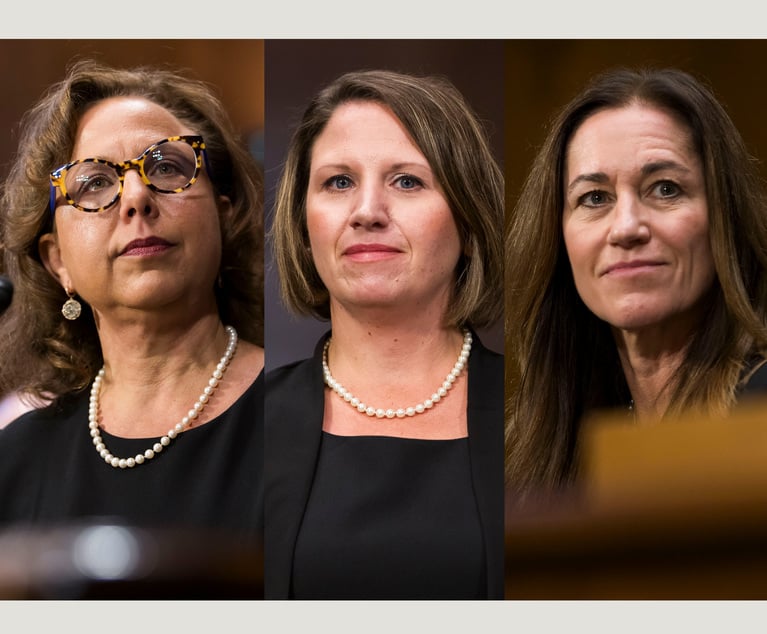Stemming the Rising Tide of Trade Secrets Misappropriation
So how do we stem what is clearly a rising tide of trade secrets disputes and actual and potential loss? If you or your clients haven't been thinking about enhanced trade secret protection, you are behind the times.
February 21, 2020 at 01:07 PM
10 minute read
 Nicole D. Galli, Law Offices of N.D. Galli LLC
Nicole D. Galli, Law Offices of N.D. Galli LLC
It seems like every week there is another trade secrets case or investigation making headlines. Just this month, Christopher Wray, director of the FBI, in a speech titled, "Responding Effectively to the Chinese Economic Espionage Threat," explained that "the FBI currently has about 1,000 investigations into Chinese technology theft." As recent news reports and cases show, state actors misappropriate trade secrets not only through cyber means, but also through partnerships with an insider, such as an employee, and otherwise seemingly legitimate business relationships. Indeed, studies show that the vast majority of the threats—even those without a state actor involved—are from some kind of insider—current and former employees or trusted business partners (e.g., joint venture partners, suppliers, customers and the like). This is corroborated in speaking with many in house counsel about these issues, as I do, as they tell me it is insider threats that keep them up at night, far more than whether their cybersecurity protection is adequate (although that's certainly an important consideration as well).
Some may wonder why trade secrets are so much more in the news these days. That's a complicated question for which there are numerous possible explanations. One factor is the impact of patent eligibility law on key technology areas such as software, business methods and medical diagnostic testing. Another factor is the increasing mobility of the workforce and the heightened level of electronic connectivity among people (such as social media and workplace communication services such as Slack), which creates situations ripe for both inadvertent and intentional trade secret loss. Of course, we cannot underestimate the impact of now having a federal trade secret law with the enactment of the Defend Trade Secrets Act in 2016 and similar laws in Europe with the implementation of 2016 EU Directive. And we also can't ignore the impact of attacks on the enforceability of restrictive covenants in certain jurisdictions. To me, however, the most important reasons are the ubiquitous nature of trade secrets—all businesses have them—and their high business value, which is being increasingly recognized. Indeed, some studies show that many businesses consider their trade secrets to be their most important form of intellectual property, even more so than their patents (which seems contrary to most IP lawyers' perspectives).
So how do we stem what is clearly a rising tide of trade secrets disputes and actual and potential loss? If you or your clients haven't been thinking about enhanced trade secret protection, you are behind the times. The old ways of relying on confidentiality agreements and NDAs, employment agreements, "need to know" rules, and cybersecurity are inadequate in today's climate. Instead, companies need what I call "trade secrets 2.0"—a multidisciplinary approach to trade secrets protection that looks to create a company culture and business processes around enhanced trade secret protection. Such systems draw upon various sectors of the company such as legal, IT, HR and R&D, and often rely upon an executive sponsor to reinforce the importance of the issue. As one study shows, as of just a few years ago, at best one-third of companies—even large multinational ones—were taking more comprehensive steps to secure their trade secrets. Many companies I know, especially smaller ones, do not even realize they have trade secrets. Yet everything that a company does that it does not share with the public and provides it with a competitive advantage is potentially a trade secret. Once companies realize how broad the definition of trade secret really is, they start realizing how many they have and how little they are doing to protect them.
To me, a first step in trade secrets 2.0 protection is identification. For most companies, trying to identify each and every trade secret the company has is a losing battle. Especially in technology and R&D-driven companies, new trade secrets can be created every day, rendering any catalog of trade secrets obsolete as soon as it is completed. This does not mean one should not try to think about this however, and at least come up with broad categories of trade secrets that the companies might have. The kinds and location of the trade secrets, for example, can inform the other steps one takes in protecting them, as can knowing how, if at all, the trade secrets need to be shared within and outside the company.
More specific identification becomes increasingly important at various entrance and exit points. One example is when employees are on-boarded or leave the company. At that time, it is helpful to at least have some idea of what trade secrets the employee will be (or was) exposed to so that proper instructions can be given for how they should be handled going forward. For many companies, avoiding having an employee utilize their prior employer's trade secrets in your company can be as important if not more important than worrying about losing your own trade secret. Such companies not only want to avoid an accusation of trade secret misappropriation, but also want to avoid having their technology contaminated with trade secrets they do not truly own. Another time that is critically important is when partnering or sharing information with another company—whether an investor, joint venture, customer, or vendor.
It is also critically important to keep trade secrets identification in mind in connection with patenting. Some (and perhaps many) patent lawyers believe that if something can be patented it should be patented and that trade secrets should be avoided. However, for some companies, maintaining key assets as a trade secret makes good business and economic sense. Think about the value of the Coca-Cola formula over the last 100-plus years, versus a single pharmaceutical patent. Even though the pharmaceutical patent is likely highly valuable, the Coca-Cola value is likely higher. In addition, most times, it is best to have a web of protection, where some aspects of an invention are patented but others are protected by trade secrets. In any event, since patenting by its very nature (invention made public) is the opposite of trade secrets (invention kept from the public), this is a key decision point. Thus if there is some technology that a company wants to keep as a trade secret, it is critically important that it not be included or disclosed in a patent even if not actually claimed in a patent. Similarly, when there is a suspected trade secret misappropriation, it is important to check the company's patents for the related technology, to be sure that there was not already a disclosure of the purported trade secret in the patents.
Once you have an idea of the kinds of information you are protecting, then you need to think about additional protections. One important factor determining what kinds of protections you need is whether this information can be controlled within a small internal group or needs to be shared within the entire company. The more people who must have access to the information the higher the risk. Similarly, the protections required will vary depending on whether it is only going to be shared internally or whether it needs to be shared with third-parties. Third-party sharing is probably the most difficult situation for which to design trade secret protection—you now are dealing with not one but two companies, which at least doubles the risk—and you may not have a lot of control over the third-party, even if you have leverage in the relationship. One way you can try to protect yourself is by conducting due diligence on the third-party. Another is by only sharing a portion of the trade secret information (if possible), keeping the rest in a black box, for example, or spreading it among a group of suppliers (so that no one supplier knows everything).
In general, every company will benefit from employee training and creating a culture around trade secret protection. Inadvertence is often as much of an issue as deliberate misappropriation. For example, sending a document containing trade secrets to a home email to work on it remotely—though well intentioned—can increase the risk of loss and should be avoided. Sharing a thorny computer programming problem with friends outside the company to get suggestions and advice might be commonplace in the industry, but again not a great practice from the perspective of trade secrets protection. However, as in house counsel will tell you, one needs to balance practical realities of the business with trade secrets protection. As with any system that depends upon employee compliance, systems that make jobs harder are less likely to be complied with and more likely to be the subject of potentially hazardous workarounds.
All systems need regular monitoring and enforcement, in addition to regular employee training. Especially for larger companies, more sophisticated technological systems can be employed, such as blocking or disabling USB drives and utilizing software and algorithms that flag large downloads or emails with attachments, as well as other suspicious behaviors. At the end of the day, however, no system is fool proof. Accidents will happen and it is highly likely a misappropriation may occur as well at some point in a company's life cycle. Even if a company chooses not to pursue a legal remedy for a particular incident, it must take action when an incident comes to light and remedial steps should be documented. As any trade secrets litigator will tell you, one of the areas for discovery in a trade secrets case is whether there were past incidents of trade secrets loss or misappropriation and whether the company took the necessary steps to address them. In this regard, attention should be given to whether remediation records should be treated as privileged or whether some records should be maintained as a business record. This could be an important question later, when one may want to rely upon a business record regarding remediation without opening the door to a full privilege waiver.
These are only a small fraction of the considerations that need to be taken into account in designing an effective system of enhanced or trade secrets 2.0 protection. As with "reasonable measures"—the standard a court uses to determine whether or not a company took the necessary steps to secure the trade secret—trade secrets 2.0 protection needs to take into account a myriad of factors too numerous to discuss here. The first step, however, is to think about the issues and develop a comprehensive plan—just relying on "old school" trade secret protections will not cut it in today's world.
Nicole D. Galli is the founder and managing partner of the Law Offices of N.D. Galli, a boutique law firm with offices in Philadelphia and New York that protects businesses' key strategic assets through corporate transactions and governance measures, intellectual property counseling and commercial litigation. She is also the founder and president of Women Owned Law (WOL), the first national networking organization dedicated to empowering and supporting women entrepreneurs in the law. Galli can be reached at [email protected] or 215-525-9583.
This content has been archived. It is available through our partners, LexisNexis® and Bloomberg Law.
To view this content, please continue to their sites.
Not a Lexis Subscriber?
Subscribe Now
Not a Bloomberg Law Subscriber?
Subscribe Now
NOT FOR REPRINT
© 2025 ALM Global, LLC, All Rights Reserved. Request academic re-use from www.copyright.com. All other uses, submit a request to [email protected]. For more information visit Asset & Logo Licensing.
You Might Like
View All
Pa. Federal District Courts Reach Full Complement Following Latest Confirmation

The Defense Bar Is Feeling the Strain: Busy Med Mal Trial Schedules Might Be Phila.'s 'New Normal'
7 minute read
Federal Judge Allows Elderly Woman's Consumer Protection Suit to Proceed Against Citizens Bank
5 minute read
Judge Leaves Statute of Limitations Question in Injury Crash Suit for a Jury
4 minute readTrending Stories
- 1'A Shock to the System’: Some Government Attorneys Are Forced Out, While Others Weigh Job Options
- 2Lackawanna County Lawyer Fails to Shake Legal Mal Claims Over Sex With Client
- 3Florida Judge Denies Motion to Dismiss in $150M Plane Crash Lawsuit Involving Flow La Movie
- 4HSF Accounts Show US Operating Losses Last Year But Revenue Increased Slightly
- 5Sheppard Mullin, Morgan Lewis and Baker Botts Add Partners in Houston
Who Got The Work
J. Brugh Lower of Gibbons has entered an appearance for industrial equipment supplier Devco Corporation in a pending trademark infringement lawsuit. The suit, accusing the defendant of selling knock-off Graco products, was filed Dec. 18 in New Jersey District Court by Rivkin Radler on behalf of Graco Inc. and Graco Minnesota. The case, assigned to U.S. District Judge Zahid N. Quraishi, is 3:24-cv-11294, Graco Inc. et al v. Devco Corporation.
Who Got The Work
Rebecca Maller-Stein and Kent A. Yalowitz of Arnold & Porter Kaye Scholer have entered their appearances for Hanaco Venture Capital and its executives, Lior Prosor and David Frankel, in a pending securities lawsuit. The action, filed on Dec. 24 in New York Southern District Court by Zell, Aron & Co. on behalf of Goldeneye Advisors, accuses the defendants of negligently and fraudulently managing the plaintiff's $1 million investment. The case, assigned to U.S. District Judge Vernon S. Broderick, is 1:24-cv-09918, Goldeneye Advisors, LLC v. Hanaco Venture Capital, Ltd. et al.
Who Got The Work
Attorneys from A&O Shearman has stepped in as defense counsel for Toronto-Dominion Bank and other defendants in a pending securities class action. The suit, filed Dec. 11 in New York Southern District Court by Bleichmar Fonti & Auld, accuses the defendants of concealing the bank's 'pervasive' deficiencies in regards to its compliance with the Bank Secrecy Act and the quality of its anti-money laundering controls. The case, assigned to U.S. District Judge Arun Subramanian, is 1:24-cv-09445, Gonzalez v. The Toronto-Dominion Bank et al.
Who Got The Work
Crown Castle International, a Pennsylvania company providing shared communications infrastructure, has turned to Luke D. Wolf of Gordon Rees Scully Mansukhani to fend off a pending breach-of-contract lawsuit. The court action, filed Nov. 25 in Michigan Eastern District Court by Hooper Hathaway PC on behalf of The Town Residences LLC, accuses Crown Castle of failing to transfer approximately $30,000 in utility payments from T-Mobile in breach of a roof-top lease and assignment agreement. The case, assigned to U.S. District Judge Susan K. Declercq, is 2:24-cv-13131, The Town Residences LLC v. T-Mobile US, Inc. et al.
Who Got The Work
Wilfred P. Coronato and Daniel M. Schwartz of McCarter & English have stepped in as defense counsel to Electrolux Home Products Inc. in a pending product liability lawsuit. The court action, filed Nov. 26 in New York Eastern District Court by Poulos Lopiccolo PC and Nagel Rice LLP on behalf of David Stern, alleges that the defendant's refrigerators’ drawers and shelving repeatedly break and fall apart within months after purchase. The case, assigned to U.S. District Judge Joan M. Azrack, is 2:24-cv-08204, Stern v. Electrolux Home Products, Inc.
Featured Firms
Law Offices of Gary Martin Hays & Associates, P.C.
(470) 294-1674
Law Offices of Mark E. Salomone
(857) 444-6468
Smith & Hassler
(713) 739-1250





